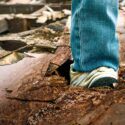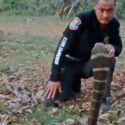Botflies are a parasitic fly located mainly in Central and South America. They’re best known for their metallic, robotic appearance. Female botflies can’t complete their life cycle unless their larvae are buried in some animal’s skin. As they grow, the larvae consume their host’s flesh. But the only species of botfly that infests humans is Dermatobia hominis.
Female botflies can also lay eggs on mosquitoes or ticks. When the infested arthropods bite a human or another mammal, they deposit larvae from those eggs. In humans, a botfly infestation looks like an irritated, red bump with a hole in the center. It’s a breathing tube for the larvae. And sometimes, you can feel movement within the bump.
How could a botfly infestation kill you? How can you remove the larvae? And why could bacon grease help?
This botfly infestation sounds scary, and if it’s not treated, the infestation can get really bad. But don’t cancel your trip to the beach just yet. Instead, follow these steps to stay safe.
Step 1. Protect your skin
Because many botflies will lay their eggs on insects, like mosquitoes, it’s hard to avoid botflies if you’re in an area where they live. So use bug spray to keep flies and mosquitos away. And if you’re going hiking, use high-top boots and long sleeves to prevent tick bites.
If you’re indoors, close your windows and doors after dark, and use window screens. Also, don’t let foods or liquids accumulate, and still use bug spray. And while you’re visiting tropical regions, remember to iron all your clothing before dressing. This is especially important if your clothes dried outside the house since the fabric may have eggs stuck in it.
Step 2. Recognize an infestation
After a female botfly or other carrier lays eggs, the larvae will hatch after about a week and rapidly penetrate your skin. Some common signs are wounds forming on your skin with redness, slight swelling and pus coming from the bite. You could also feel something moving around under your skin, pain or intense itching.
Usually, a dermatologist or infectologist observes the wounds and diagnoses the botfly infestation. In 2018, a Florida woman came back from her honeymoon in Belize. Two months later, she noticed a skin lesion that was itchy but not painful. So she went to her doctor, who suspected it was an infected spider bite and prescribed antibiotics. But the antibiotics didn’t help, so she got a second opinion at a wound management clinic.
Her wound had a hole in the center with pus coming out of it. And the bite felt hard to the touch, as if there were a bean or an egg inside it. When the doctors cut open the lesion, they found an insect with a tapered shape and rows of spines and hooks. Pathologists identified it as a human botfly larva.
The specialist said that if the larva had not been surgically removed, it could have matured into an adult fly and creating a bigger hole in her skin as it grew. Within a week of its removal, her skin had completely healed.
Step 3. Remove the larva
The most common method of removing a botfly larva is to apply a topical anesthetic, slightly enlarge the opening, and use forceps or tweezers to remove the larva. Other methods include using a venom extractor syringe to suck the larvae out. And taking the antiparasitic drug avermectin causes the larvae to suddenly leave the skin.
Also, flooding the opening with iodine can make the fly poke out of the hole so it can be removed with forceps. Another way to kill the larva is by suffocating it. Seal its breathing hole with something greasy like petroleum jelly. But if you don’t have any, bacon grease can work just as well. Then enlarge the hole and remove the dead carcass with forceps.
Step 4. Don’t squeeze it out
Forcefully squeezing the larvae out like you’re popping a pimple can work, but it can also be dangerous and painful. The larva’s spines can get stuck in your skin, and rupturing the larva’s body can cause anaphylactic shock. That makes it harder to remove all parts of the bug, increasing your chance of an infection. Even though a botfly infestation is not too dangerous on its own, neglecting an infection can kill you.
So if you visit Central or South America, be very cautious around damp and forested areas, and you should be able to avoid becoming infested by botflies. But botflies aren’t the only creepy creatures you should watch out for. Something else is waiting to poke your skin and drink your blood.
Sources
- “Fascinatingly Gross Botfly Facts”. Anne Marie Helmenstine, Ph.D. 2021. Thoughtco.
- “A Look At Human Botfly Infestation – Outbreak News Today”. 2016. Outbreak News Today.
- “A Baby Fly Burrowed Into A Woman’s Skin During Belize Honeymoon. She Noticed It 2 Months Later.”. 2018. livescience.com.
- “Treating parasitic human botfly”. 2021. nursingcenter.com.
- “Human Botfly Infection: What Is It & How To Remove”. Tua Saúde.



























